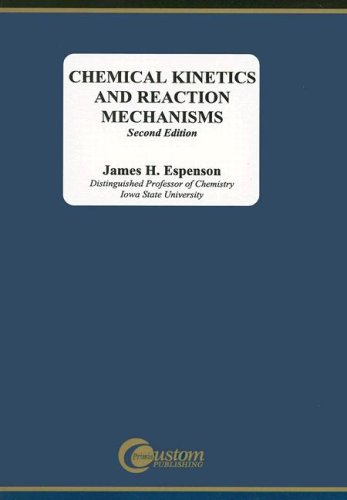Chemical kinetics and reaction mechanisms pdf download
Par moore leslie le lundi, novembre 23 2015, 23:22 - Lien permanent
Chemical kinetics and reaction mechanisms. James H. Espenson

Chemical.kinetics.and.reaction.mechanisms.pdf
ISBN: 0070202605,9780070202603 | 296 pages | 8 Mb

Chemical kinetics and reaction mechanisms James H. Espenson
Publisher: McGraw-Hill Science/Engineering/Math
Abstract: Recent studies have shown that heterogeneous reactions of hydrogen peroxide (H2O2) on aerosol surfaces may play an important role in tropospheric chemistry. The E-selectivity commonly observed in the case of semi-stabilised and stabilised ylides is explained by a kinetic preference for the formation of trans-OPA, which decomposes to form the E-alkene. Main article: Chemical kinetics. On the basis of the known chemical reactions and diffusion rates of Rf and oxygen into the cornea, the authors developed a theoretical model consistent with corneal oxygen consumption experimental results during UV-A irradiation under It is suggested that the main photochemical kinetics mechanism is the direct interaction between Rf triplets and reactive groups of corneal proteins, which leads to the cross-linking of the proteins mainly through radical reactions. Compton Published: January 1978 Comprehensive Chemical Kinetics - (Vol 42) - 9780444513663. Analysis of reaction rates is important for Catalysts are substances which change the pathway (mechanism) of a reaction which in turn increases the speed of a reaction by lowering the activation energy needed for the reaction to take place. The rate of a chemical reaction is a measure of how the concentration or pressure of the involved substances changes with time. Additionally, the base H/N/O mechanism was expanded to include carbon chemistry and was tested against flames of dimethylamine, ethylamine, and a methane/ammonia mixture. What we discovered here is that tunneling can dominate a reaction mechanism sufficiently to redirect the outcome away from traditional kinetic control. The study of chemical kinetics includes investigations on how different experimental conditions can influence the speed of chemical reactions and produce information about the reaction's mechanism and transition states. Chemical dynamics is defined to encompass reaction kinetics and mechanisms, intramolecular rearrangement or conformational changes, and changes induced via electromagnetic excitation. The mechanism for nickel-catalyzed hydrosilylation of benzaldehyde has been studied by chemical kinetics, identification of reaction intermediates, and isotope-labeling studies. This clarification of the mechanism for the lithium salt-free Wittig reaction will likely feature in future editions of undergraduate textbooks and will encourage many chemistry lecturers to update their course notes before the start of the new academic year.
Handbook of Pharmaceutical Controlled Release Technology ebook download
Giorgio Agamben: A Critical Introduction ebook